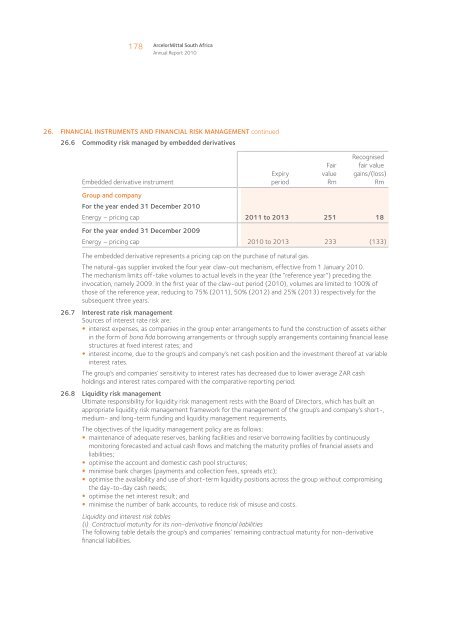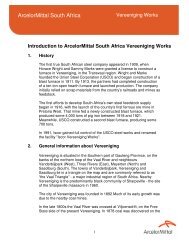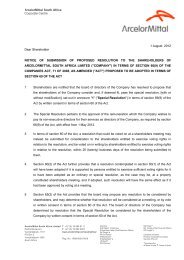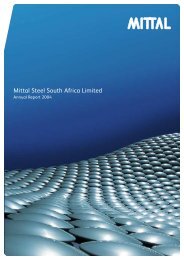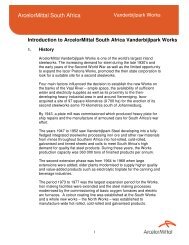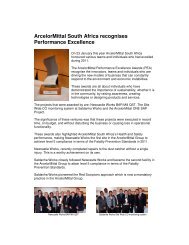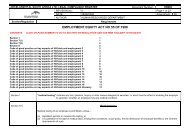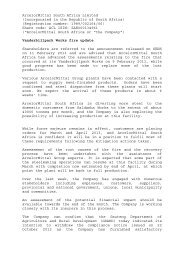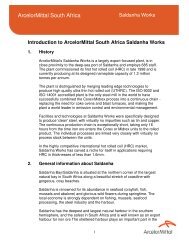bold spirit - ArcelorMittal South Africa
bold spirit - ArcelorMittal South Africa
bold spirit - ArcelorMittal South Africa
You also want an ePaper? Increase the reach of your titles
YUMPU automatically turns print PDFs into web optimized ePapers that Google loves.
178<br />
<strong>ArcelorMittal</strong> <strong>South</strong> <strong>Africa</strong><br />
Annual Report 2010<br />
26. FINANCIAL INSTRUMENTS AND FINANCIAL RISK MANAGEMENT continued<br />
26.6 Commodity risk managed by embedded derivatives<br />
Embedded derivative instrument<br />
Expiry<br />
period<br />
Fair<br />
value<br />
Rm<br />
Recognised<br />
fair value<br />
gains/(loss)<br />
Rm<br />
Group and company<br />
For the year ended 31 December 2010<br />
Energy – pricing cap 2011 to 2013 251 18<br />
For the year ended 31 December 2009<br />
Energy – pricing cap 2010 to 2013 233 (133)<br />
The embedded derivative represents a pricing cap on the purchase of natural gas.<br />
The natural-gas supplier invoked the four year claw-out mechanism, effective from 1 January 2010.<br />
The mechanism limits off-take volumes to actual levels in the year (the “reference year”) preceding the<br />
invocation, namely 2009. In the first year of the claw-out period (2010), volumes are limited to 100% of<br />
those of the reference year, reducing to 75% (2011), 50% (2012) and 25% (2013) respectively for the<br />
subsequent three years.<br />
26.7 Interest rate risk management<br />
Sources of interest rate risk are:<br />
• interest expenses, as companies in the group enter arrangements to fund the construction of assets either<br />
in the form of bona fida borrowing arrangements or through supply arrangements containing financial lease<br />
structures at fixed interest rates; and<br />
• interest income, due to the group’s and company’s net cash position and the investment thereof at variable<br />
interest rates.<br />
The group’s and companies’ sensitivity to interest rates has decreased due to lower average ZAR cash<br />
holdings and interest rates compared with the comparative reporting period.<br />
26.8 Liquidity risk management<br />
Ultimate responsibility for liquidity risk management rests with the Board of Directors, which has built an<br />
appropriate liquidity risk management framework for the management of the group’s and company’s short-,<br />
medium- and long-term funding and liquidity management requirements.<br />
The objectives of the liquidity management policy are as follows:<br />
• maintenance of adequate reserves, banking facilities and reserve borrowing facilities by continuously<br />
monitoring forecasted and actual cash flows and matching the maturity profiles of financial assets and<br />
liabilities;<br />
• optimise the account and domestic cash pool structures;<br />
• minimise bank charges (payments and collection fees, spreads etc);<br />
• optimise the availability and use of short-term liquidity positions across the group without compromising<br />
the day-to-day cash needs;<br />
• optimise the net interest result; and<br />
• minimise the number of bank accounts, to reduce risk of misuse and costs.<br />
Liquidity and interest risk tables<br />
(i) Contractual maturity for its non-derivative financial liabilities<br />
The following table details the group’s and companies’ remaining contractual maturity for non-derivative<br />
financial liabilities.


